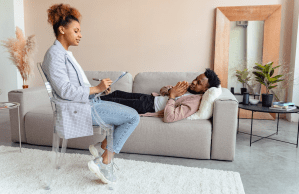Every single one of us harbors insecurities, whether they have to do with our looks, our interests, our actions, or our mere associations—it’s a part of being human. But some of us allow these insecurities, this self-doubt to fester and completely rule our lives… and that’s when it becomes harmful. If you have crippling self-doubt that’s negatively affecting your daily life, it’s time to make some changes. Follow these six tips for overcoming that self-doubt and becoming a healthier, happier, and more confident you:
1) Acknowledge your insecurities.
First and foremost, you must acknowledge the source of your self-doubt, or, in other words, your insecurities. “Don’t try to fight or hide your insecurities; instead, start acknowledging them,” says Licensed Clinical Social Worker and Relationship Therapist Irina Baechle. “This way, you don’t spend your limited energy on trying to avoid the important issues, but on resolving them. It’s like that saying about the pink elephant in the room—what are you going to think about if I tell you to not think about the pink elephant?”
2) Challenge negative thoughts.
Once you’ve identified the source of your self-doubt, Nancy Lipson—Registered Social Worker, Therapist, and founder of Accept Yourself Therapy Centre—says “the key is to find ways to challenge these beliefs. This can be accomplished by looking at what assumptions the person is making about themselves in these situations, finding evidence that supports that assumption, and evidence that is not in support of that assumption.”
3) Identify alternative ways of thinking.
Dr. Ariane Machin, PhD-trained psychologist and co-founder of the Conscious Coaching Collective, says the next important step is to identify and adopt other ways of thinking. “Identify alternatives—alternative ways of thinking about situations and have the courage to be all in. This is one of the most important parts, as many times confidence comes by doing… not just thinking.” She goes on to say that you should do what you’re scared of, what you think you can’t accomplish. And to begin with baby steps… one step at a time.
4) Show yourself some love.
Licensed Mental Health Counselor Rachel Gersten recommends individuals also show themselves some love. “They should put motivational messages around their house where they’re going to see them. I suggest the bathroom mirror, on their front door, or even as a background on their phone,” she says. “It’s a way to make sure they’re getting positive messages to counteract all the negative self-talk In their heads. I also suggest people look in the mirror and say out loud, ‘I am strong/brave/smart/capable.’ Whatever adjective feels best for them works. The more they are exposed to those message, the sooner they can also start to believe them.”
5) Set realistic expectations.
Moving forward, it’s crucial you set realistic expectations for yourself, as explained by Dr. Carly Snyder: “Establish expectations for yourself and stick to these goals—if you decide the mark of beauty is being at least 5’10 and you are 5’2 then you are doomed to fail. Instead, buy a great pair of heels and an outfit you love and strut your stuff feeling your tallest. If you are a runner and you never feel good enough about your race times, join a running group and sign up for a 10k. If you decide that you are only a winner if you literally win, then chances are you will be disappointed—but if you set your sights on training well and beating your previous times, even by a second, then you’re on your way to feeling more secure and accomplished.”
6) Fake it ‘til you make it.
And lastly, Billie Bemis—Licensed Marriage and Family Therapist and Licensed Addiction Counselor—says it can pay off to pretend for a little while. “Sometimes when you’re struggling with self-doubt, it helps to fake it ‘til you make it. Consider how a person that has what you want—whether it be confidence, abilities, certain qualities, etc. would act, feel, and behave. Once you’ve got a good picture in your head of how such a person would be, try on some of those foreign feelings and behaviors yourself. See what it would be like to feel that way or behave that way. Initially, it will be acting as if, but with practice it can become a natural state for you too.”













